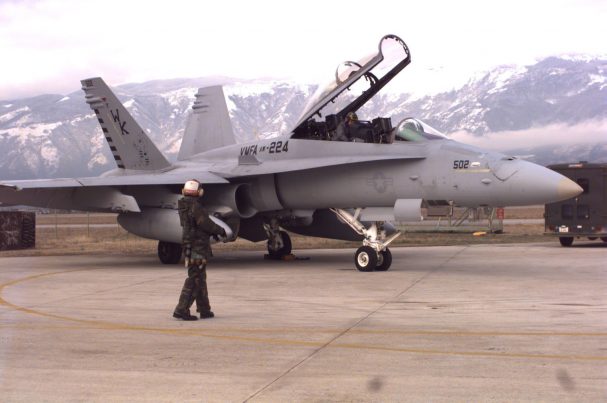
Marine F/A-18 Hornet fleet so decimated the Corps is resurrecting retired planes and borrowing some from the Navy
Monday, July 04, 2016 by usafeaturesmedia
http://www.nationalsecurity.news/2016-07-04-marine-fa-18-hornet-fleet-so-decimated-the-corps-is-resurrecting-retired-planes-and-borrowing-some-from-the-navy

(NationalSecurity.news) It’s not a good time for Marine Corps aviation.
As reported by the Marine Corps Times, most of the service’s current F/A-18 Hornet fleet is unable to fly on any given day, and the situation has gotten so bad that USMC aviation brass are turning to boneyards to refurbish 23 retired aircraft.
At the same time, the Corps is borrowing seven planes from its sister service, the U.S. Navy.
The move comes as both services are fighting an internal battle as well as flying endless sorties overseas against a low-tech enemy: The struggle to keep F/A-18s serviceable and intact until the troubled F-35 Joint Strike Fighter can replace the aging fighters.
“We are very focused on our current readiness, and at the moment, we don’t have enough Hornets for combat, flight instruction and day-to-day training,” said Capt. Sarah Burns, a Marine spokeswoman at the Pentagon.
The Hornet is unique in that it is the first U.S. strike fighter – it can engage in air-to-air combat as well as serve in a ground support role bombing targets. The original Hornet and the newer F/A-18 E-F Super Hornet were supposed to be phased out in the mid-2020s and 2035 respectively, but because the F-35 is so problem-plagued and behind schedule (and expensive), the USMC and the Navy have had to find ways – and the money – to keep the F/A-18 squadrons flying a lot longer.
The 30 planes headed back into Marine Corps service will be upgraded to the C+ configuration, according to Burns. That means they will include updates to flight-deck displays and a joint helmet-mounted cueing system that gives pilots more control over the aircraft, Boeing told Marine Corps Times.
However, nothing happens for now. It takes between nine and 18 months per plane to upgrade, depending on the aircraft’s condition. Beginning in 2017, however, Boeing says it will be able to refurbish 10 Hornets annually.
Most of the mothballed Hornets were put in storage at the 309th Aerospace Maintenance and Regeneration Group at Davis-Monthan Air Force Base in Arizona, which is commonly known as the “boneyard.”
“We purposely housed the aircraft in the 309th Aerospace Maintenance and Regeneration Group … over the course of a decade with intent to store, maintain and upgrade them for today’s use,” Burns said.
That turned out to be a wise decision on the part of Marine Corps aviation planners, which some experts tried to spin as an overall positive despite the service’s current dearth of usable planes.
Retired Marine Lt. Col. Dakota Wood, a senior research fellow at the Heritage Foundation think tank in Washington, said it is common for the military to “mothball” ships, planes, tanks and other equipment it doesn’t currently need.
“When this happens, it makes sense to place the items in long-term storage to avoid both the maintenance costs of keeping the equipment in ready-to-use condition and wasting taxpayer dollars by destroying equipment that still has useful life,” Wood told Marine Corps Times. “Resurrecting older equipment also mitigates the costs in time and money of building new items unless the old item has truly become obsolete relative to threats and missions it was originally designed to handle.”
That said, other experts noted that there indeed is an expense – and a risk – in refurbishing mothballed gear.
Retired Navy Cmdr. Chris Harmer, senior naval analyst at the Institute for the Study of War, said the F/A-18s can certainly be inspected and reconstituted to full-mission status, but not without hazards.
“After sitting in the desert for a decade, nobody really knows what condition they are in until they get to the depot-level maintenance facility and are opened up and inspected” Harmer said.
He added that Marine Corps aviation is “on the verge of systemic failure” because the fleet has been overused since Sept. 11, 2001. He also said that the F-35 is years – and tens of billions of dollars – behind schedule.
“This is not the fault of the Marine Corps, but the Marines will pay the price for it through excess pilot mortality, and the U.S. will face a significant strategic risk in the near future if deployable Marine tactical aviation suffers a significant decrease in availability, which now seems inevitable,” he said.
A congressional staffer told the Times that all services are coping with too much to do and not enough to do it with thanks to Obama-era budget cuts (sequestration) for which Congress bears some responsibility as well.
More:
- Documents: Marine Corps At Risk Of Lapsing Into ‘Irrelevance’ If Major Changes Not Made
- U.S. Army To Preposition War Material, Gear In Asia And Europe To In Preparation For Rising Threats
- Coming Soon: A U.S. Air Force That Can’t Afford Its Fighters
NationalSecurity.news is part of the USA Features Media network. Get caught up on ALL of the day’s most important news and information here.
Tagged Under: Tags: F/A-18, Marine Corps






